Research shows that automation trends may be widening the racial wealth gap. This article reveals possible interventions that may help African American workers prepare for the future.
There is a well-documented, persistent, and growing racial wealth gap between African American families and white families in the United States. Studies indicate the median white family in the United States holds more than ten times the wealth of the median African American family.
Apart from its obvious negative impact on African American individuals, families, and communities, the racial wealth gap constrains the entire US economy. In a previous report, we projected that closing the racial wealth gap could net the US economy between $1.1 trillion and $1.5 trillion by 2028.
Despite this, the racial wealth gap threatens to grow as norms, standards, and opportunities in the current US workplace change and exacerbate existing income disparities. One critical disrupter will be the adoption of automation and other digital technologies by companies worldwide. According to estimates from the McKinsey Global Institute, companies have already invested between $20 billion and $30 billion in artificial intelligence technologies and applications. End users, businesses, and economies are hoping to significantly increase their productivity and capacity for innovation through using such technologies.
As determined in our previous report on the racial wealth gap, African Americans start from a deprived position in the workforce, with an unemployment rate twice that of white workers, a pattern that persists even when controlling for education, duration of unemployment, and the cause of unemployment.2 Our prior research also shows that African Americans could experience the disruptive forces of automation from a distinctly disadvantaged position, partially because they are often overrepresented in the “support roles” that are most likely to be affected by automation, such as truck drivers, food service workers, and office clerks.
This article builds on these findings using a new and proprietary data set compiled by MGI to construct a 2030 scenario that projects the impact of automation in the national workplace and specific US counties. We reviewed this demographic and employment data in 13 distinct community archetypes across the country to test our previous findings and discover if African Americans are overrepresented in both at-risk roles and within US regions that are more likely to see job declines because of automation.3
This approach allowed us to examine the “economic intersectionality” of race, gender, age, education, and geography as it relates to the future of work for African Americans.4 Economic intersectionality can refer to the compounded effects of any combination of characteristics associated with economic disadvantage. In this article, we focus on differing levels of automation-based challenges for African American men and women of various ages and education levels in rural and urban America.
We project that African Americans in the 13 community archetypes we analyzed may have a higher rate of job displacement than workers in other segments of the US population due to rising automation and gaining a smaller share of the net projected job growth between 2017 and 2030. By 2030, the employment outlook for African Americans—particularly men, younger workers (ages 18–35), and those without a college degree—may worsen dramatically. Additionally, we find that African Americans are geographically removed from future job growth centers and more likely to be concentrated in areas of job decline. These trends, if not addressed, could have a significant negative effect on the income generation, wealth, and stability of African American families.
The challenges are daunting, but our research reveals opportunities for improvement within the African American workforce through strengthening local economies, shifting education profiles to align with growing sectors, engaging companies and public policy makers in developing reskilling programs, and redirecting resources to ease the transition as automation changes the landscape for African American workers. In this article, we share our findings and note some potential interventions—some of which have already begun.
Understanding the 2030 risk for African Americans
Given that African American workers face a significant amount of risk from the rise of automated technologies in the workplace—and in an effort to identify the most targeted and effective interventions—we analyzed a range of relevant factors including occupations that are most at risk from automation, job growth, and decline in various regions of the United States, and the disproportionate impacts of automation on African American subpopulations. Taken together, these factors reveal the macrolevel and local-level impact of job loss on African Americans.
Occupations
As shown in prior research, African Americans are overrepresented in occupations likely to be most affected by automation, and this remains accurate for our 2030 projection. In addition, African Americans are underrepresented in the occupational categories that are most resistant to automation-based displacement. African Americans are overrepresented in office support, food services, and production work industries (Exhibit 1). These industries are most vulnerable to a net loss in jobs. Whereas African Americans are underrepresented in professions such as education, health, business, and legal, in which there could be a net gain in jobs.
Exhibit 1
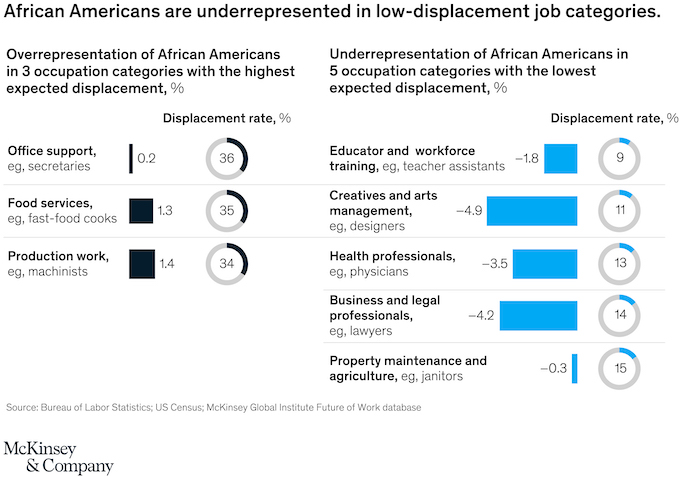
We strive to provide individuals with disabilities equal access to our website. If you would like information about this content we will be happy to work with you. Please email us at: McKinsey_Website_Accessibility@mckinsey.com
Our research also shows that African Americans tend to hold occupations at the lower end of the pay scale. Only half of the top ten occupations that African Americans typically hold pay above the federal poverty guidelines for a family of four ($25,750),5 and all ten of those occupations fall below the median salary for a US worker ($52,000) (Exhibit 2).6 Many of these occupations are among the top 15 occupations most at risk of automation-based displacement and are also projected to affect young African American workers without a college degree.
Exhibit 2
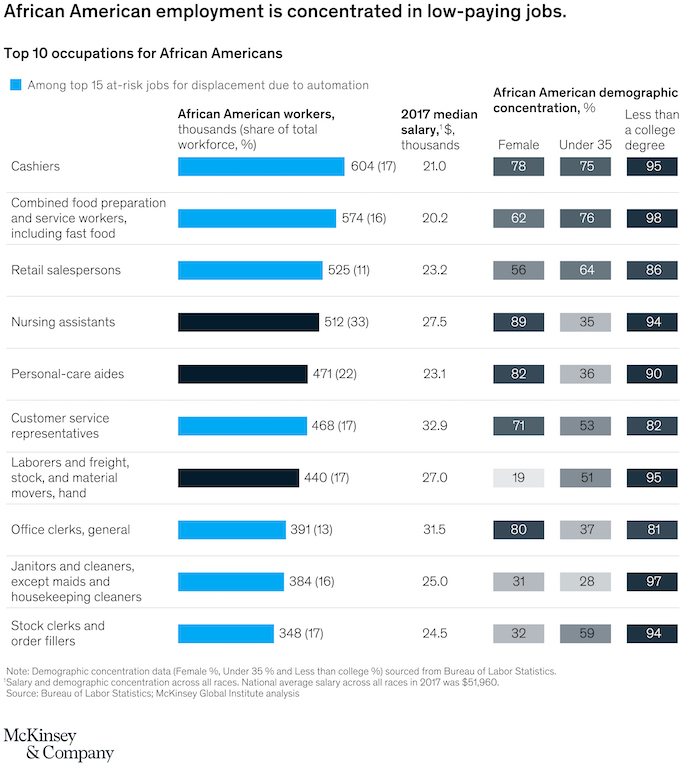
We strive to provide individuals with disabilities equal access to our website. If you would like information about this content we will be happy to work with you. Please email us at: McKinsey_Website_Accessibility@mckinsey.com
We measured job displacement as a percentage of jobs potentially lost due to automation by 2030 and found that because of their concentration in occupations at risk of automation, African Americans have one of the highest rates of potential job displacement when compared with other groups. While the Asian population has a displacement rate of 21.7 percent and the white population has a displacement rate of 22.4 percent, the African American population has a potential displacement rate of 23.1 percent, which is outpaced only by the Hispanic/Latino population displacement rate of 25.5 percent. While these differences may seem minimal, they translate to a potential loss of approximately 132,000 African American jobs due to automation by 2030.
Our 2030 scenario also indicates that African Americans could capture a smaller share of new job growth in the economy compared with white and Asian populations based on the current job-growth outlook for these groups. There is also a possibility that higher-growth occupations that currently have a high representation of African Americans may become more attractive to workers of other races, further reducing the already small share of new jobs available to African Americans by 2030.
Community archetypes
Occupational distribution within the African American community and geographic concentration both affect the potential for job displacement or growth. Building on MGI’s prior identification of 13 discrete community archetypes, we were able to analyze the employment prospects for African Americans in different areas of the United States in the projected wake of automation.
The largest amount of projected African American job disruption from automation could be in areas with the largest African American populations—particularly in megacities, such as the counties that include Chicago and Washington, DC, and in stable cities, such as the counties that include Detroit and Baltimore. However, these geographic archetypes also show the disconnect between areas where African Americans are currently concentrated and areas most likely to see job growth. African Americans are underrepresented in five out of the six projected fastest-growing geographical archetypes and are overrepresented in two of the six slower-growing archetypes, including the one archetype that has shown negative growth—distressed americana (Exhibit 3). Distressed americana showed negative net job growth from 2007 to 2017 and is projected to show negative job growth through 2030. African Americans in these distressed areas may disproportionately feel the negative effects of impending economic and technological changes, see fewer new opportunities, and face additional challenges in transitioning to the economy of the future.
Exhibit 3
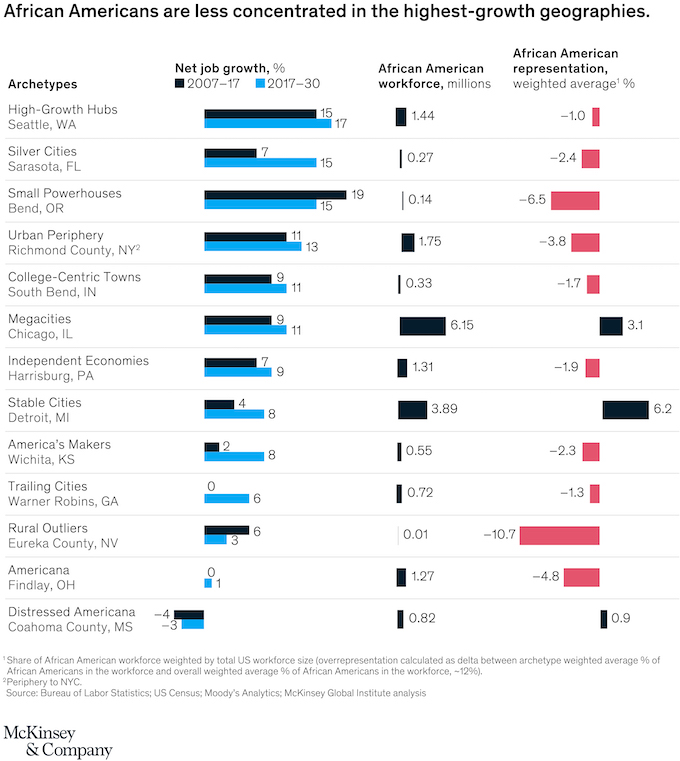
Preparing for the future
There are many challenges, as the numbers show, but opportunities for African American workers and public- and private-sector institutions to limit the adverse effects of automation remain. Our research and experience in the field point to two sets of solutions that can help alleviate the challenges compounded by economic intersectionality. The first set of solutions targets geographies—that is, improving economic conditions in regions in which African Americans are currently concentrated or enabling African American worker mobility. The second set targets capabilities—that is, improving skill development and education levels in the African American community to create additional pathways to better occupations that could be at lower risk of disruption by automation.
Geographies
Several approaches related to geographies can help assuage the challenges automation poses to African Americans.
Improving the regions where African Americans live. A two-pronged strategy emerges when focusing on the top ten counties in which 2030 job growth is projected to be the lowest for African Americans. First, there are areas of the United States, primarily in the stable cities archetype, in which African Americans are expected to bear a disproportionate burden of job losses compared with other racial groups in the workforce. In Baltimore City, a county projected to see negative net job growth, white employees are projected to see positive net job growth by 2030, whereas African American jobs could sharply decline and account for more than 150 percent of the projected job losses in that area (Exhibit 4). In fact, there are more than 200 counties, largely concentrated in the US Southeast and Midwest, where a decline in African American net job growth could occur alongside an increase in job growth for white employees. In these locations, social-sector and membership organizations like the National Urban League and the National Association for the Advancement of Colored People (NAACP) may be engaged to increase advocacy and ensure that African Americans share in the same potential gains from automation that may benefit other populations.
Exhibit 4
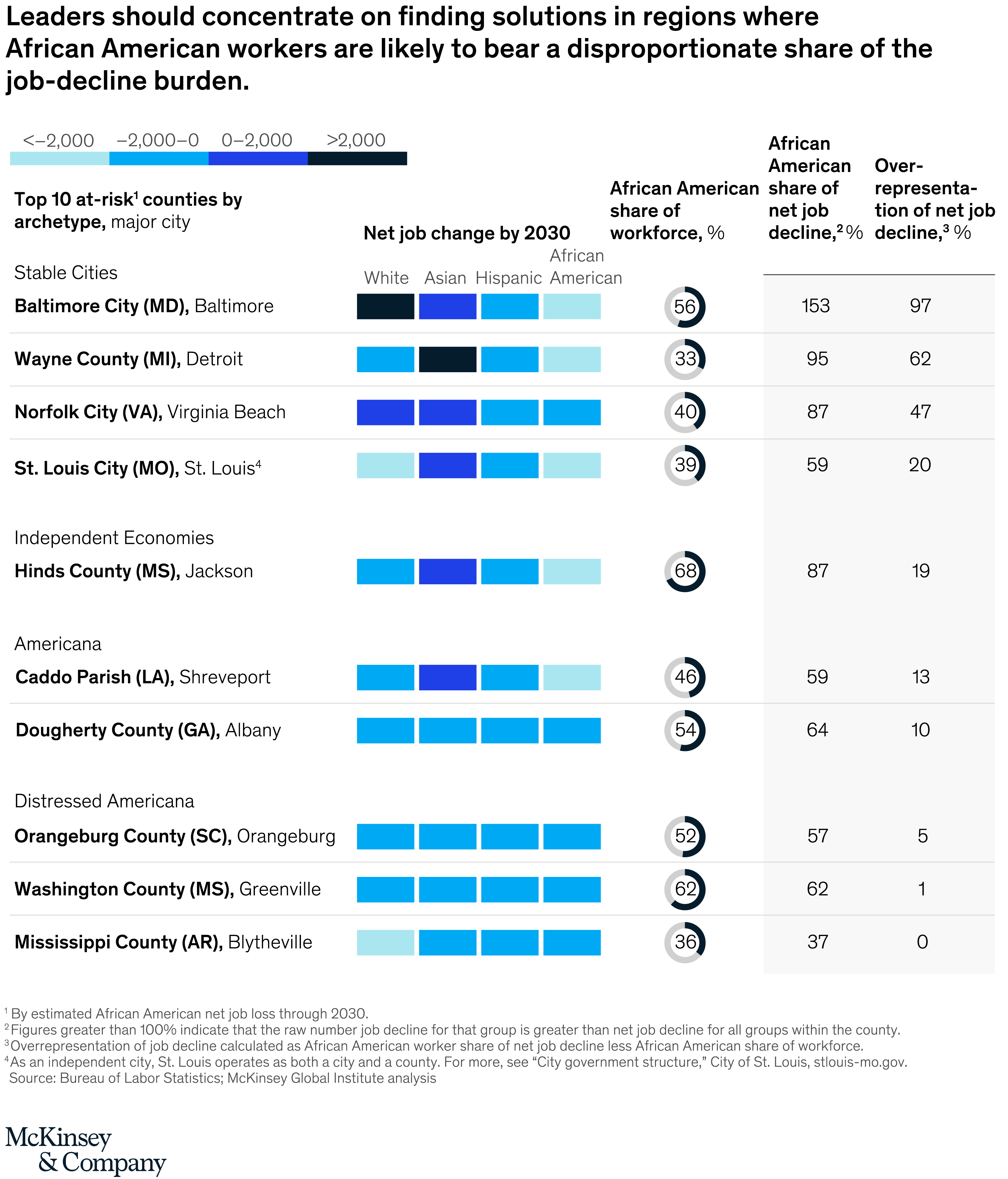
We strive to provide individuals with disabilities equal access to our website. If you would like information about this content we will be happy to work with you. Please email us at: McKinsey_Website_Accessibility@mckinsey.com
Second, there are counties in which all populations (including African Americans) could see potential job losses, such as distressed americana areas like Greenville, Mississippi, or Orangeburg, South Carolina. For these counties, public- and private-sector institutions can pursue large-scale economic-development strategies to increase jobs and opportunities. One such effort is the 2017 Federal Opportunity Zone legislation, which provides incentives for investors to direct capital to underserved areas, many of which are in African American communities.7 Opportunity Zones, within a framework that prevents neighborhood displacement, can provide capital to help accelerate a broader economic-development agenda and help finance investment in African American communities such as mixed-use development, affordable housing, and venture investing. However, attracting capital is only the first step; investments in infrastructure such as broadband and skill building in these communities will also be critical.8
Growth in new and growing regions. Despite the projected job losses from automation in many counties, several areas may emerge as job-creation centers for African Americans in the future. Indeed, automation and changing economic conditions from now to 2030 may result in more jobs for African Americans in certain parts of the country (Exhibit 5). Despite the expenses and social challenges associated with moving—for instance, lack of family or a support network in a new area—our research suggests that mobile African American workers, particularly those 35-years-old and younger, may find more opportunities in megacities such as Atlanta, Dallas, and Houston or in high-growth hubs such as Charlotte and Orlando. Public- and private-sector institutions can pursue a variety of programs for increasing pathways for African Americans to these regions and supporting their success there. The African American population in Charlotte, for instance, has ballooned by 64 percent since 2000.9 Officials in that city recently approved more than $200 million in bonds to improve transportation and affordable housing to support the city’s growth and stability.10
Exhibit 5
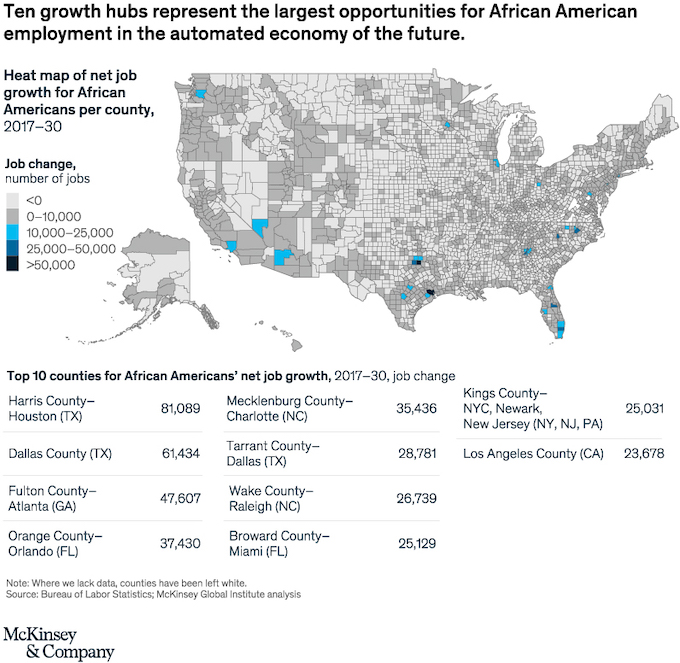
We strive to provide individuals with disabilities equal access to our website. If you would like information about this content we will be happy to work with you. Please email us at: McKinsey_Website_Accessibility@mckinsey.com
However, increasing the mobility of some employees can make economic development in distressed parts of the country even more difficult by decreasing the pool of potentially skilled employees. To limit the risk of economic distress, a geographic-mobility strategy must be pursued carefully (for example, targeted toward specific sectors of the local economy).
Capabilities
Three interventions related to the accumulation and deployment of skills and capabilities can also help stem the challenges automation poses to African Americans.
Supporting attainment of higher education. Disparities in educational attainment are a primary contributor to the increased risk of job disruption from automation for the African American workforce. The projected displacement risk drops significantly for African American and white employees who have bachelor’s degrees. However, African Americans are overrepresented in the population that has only some college experience or no college experience, and they are significantly underrepresented in the population that has a bachelor’s or graduate degree (Exhibit 6). Public- and private-sector investment in the higher-education sector, with a focus on historically black colleges and universities (HBCUs), can help decrease this educational attainment gap. HBCUs educate and train almost 20 percent of all African American college graduates despite making up only 3 percent of the country’s colleges and universities.11
Exhibit 6

We strive to provide individuals with disabilities equal access to our website. If you would like information about this content we will be happy to work with you. Please email us at: McKinsey_Website_Accessibility@mckinsey.com
Beyond investing in HBCUs, the higher-education sector can seek to improve retention and completion rates for African Americans. Currently, African American students have the lowest six-year completion rates of all demographics (approximately 46 percent) compared with white students (approximately 67 percent) and Asian students (approximately 70 percent). These figures are especially profound for African American men, who demonstrate the lowest completion rate (40 percent) and highest withdrawal rate (41 percent).12 There are numerous causes of these disparities including socioeconomic background, attendance at K–12 schools that lack a rigorous college preparatory curriculum, and lack of support at colleges and universities for first-generation students.13
Colleges and universities can better retain and graduate African American students through targeted programs that increase preparation, provide focused financial support, and prevent feelings of isolation. Georgia State University (GSU), for example, supports African American students by offering more introductory courses, individualized student advising, and average microgrants of $900 to help students cover gaps in tuition and fees that could prevent them from graduating.14 Through these and other initiatives (for example, decreasing summer-to-fall attrition through an artificial intelligence–enabled student portal), GSU has doubled its six-year graduation for African Americans in less than 15 years.15
It is critical to not only invest in improving African American outcomes in high-quality higher-education institutions but also decrease enrollment in for-profit education. Research shows that 28 percent of African American students have attended a for-profit institution compared with just 10 percent of white students.16 While some for-profit institutions are making significant strides to support African American students, attendance at for-profit institutions has been linked to poor job outcomes and a higher risk of student-loan default, which further exacerbates the racial wealth gap.17
Aside from higher-education programs aimed at bachelor’s and graduate degrees, increasing African American access to sub-baccalaureate programs may decrease job displacement. Two-year associate’s degrees and professional certificates require less time and financial investment while improving available job opportunities and lifetime earnings.18 These credentials provide access to skills in demand within the “middle-skill workforce,” giving earners an advantage over their counterparts with only a high school diploma.19 For African Americans most susceptible to automation-driven disruption, these programs will offer access to fields including health, business, and legal with potential net job growth.
Future of Work
Matching hiring criteria to occupation competencies. Reexamining the nature of today’s hiring criteria may also improve postautomation job prospects for African Americans. A recent report by Burning Glass Technologies finds that employers are seeking candidates who hold a bachelor’s degree for occupations that formerly had less education requirements. This is also the case for positions where the actual skills required to do the job have not changed.20 Given the lower levels of educational attainment in the African American workforce, these increased requirements can obstruct large portions of the workforce from opportunities. For that reason, private- and public-sector organizations could explore changing hiring policies to prioritize hiring skilled workers rather than require workers obtain university degrees. Organizations such as Opportunity@Work have advocated for removing bachelor’s degree requirements from occupation descriptions where necessary, such as in the case of administrative assistants.21 Recently, leading companies such as Apple and Home Depot have redefined their occupation requirements to value hands-on experience in the same light as academic credentials.22
Enabling occupation switching and reskilling. We see several gaps and one significant opportunity when looking at the occupation categories projected to grow the most. African Americans are overrepresented in the highest-growing occupational category: health aides, technicians, and wellness. As previously noted, the overrepresentation of African American women in these professions primarily drives this outcome. Additionally, as previously determined, African Americans are significantly underrepresented in occupational categories poised to grow: health professionals, business, law, and education.
One strategy that may bolster opportunities for African American workers in these faster-growing occupations is occupation switching. Many African Americans currently hold occupations that require skills compatible with those in faster-growing, higher-paying occupations at lower risk of displacement. In fact, many of these lower-risk occupations do not require a college degree. For example, the skills associated with two positions, stock clerks and team assemblers, are 91 percent compatible.23 However, team assemblers are paid $6,000 more annually than stock clerks and are projected to see an increase in job opportunities, while stock clerks could see a significant decline due to the rise of automation. Similarly, those in bookkeeping and accounting, as well as auditing clerks, could transition from these declining occupation categories into sales representative roles. Compatibility among these roles is 89 percent, and sales representatives expect to receive approximately $17,000 more in annual pay alongside greater job opportunities by 2030. Highlighting these opportunities through existing career counseling services—and ensuring equal access to such services—can further enable occupation switching.
Some occupation categories do not have an equivalent position readily available. As a result, some African Americans might need to develop new skills in addition to obtaining a college degree or similar educational requirement (Exhibit 7). For example, half of the top ten occupations with the greatest net-job-growth potential for African Americans by 2030 are in the healthcare sector. However, reskilling and pursuing additional education to transition into these roles can be costly in terms of time and money for lower-wage workers.
Exhibit 7
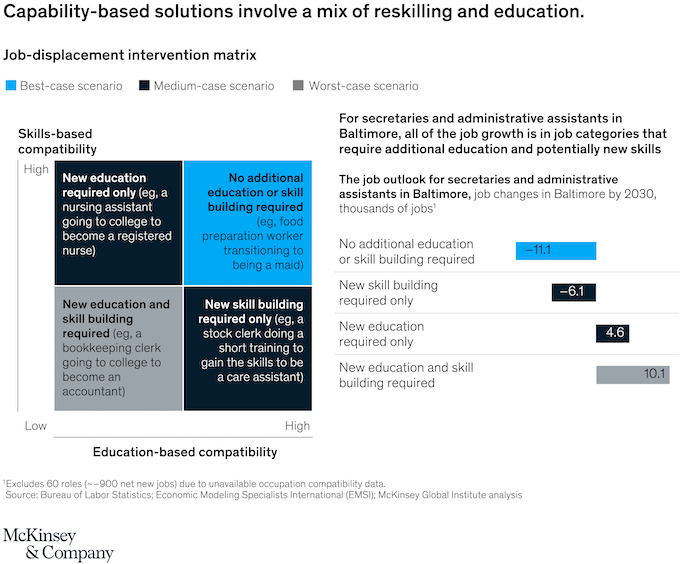
We strive to provide individuals with disabilities equal access to our website. If you would like information about this content we will be happy to work with you. Please email us at: McKinsey_Website_Accessibility@mckinsey.com
The public and private sectors will need to implement targeted programs to increase the awareness of automation risk among African American workers. Additionally, both sectors will need to provide African Americans with opportunities for higher education and the ability to transition into higher-paying roles and occupations.
Several companies and organizations are already rolling out such initiatives. Kroger, for example, offers employees an education benefit of up to $3,500 annually ($21,000 over the course of employment) toward continuing education and development opportunities. Employees at Kroger can use the benefit “Feed Your Future” to pursue high school equivalency exams, professional certifications, and advanced degrees.24 Other employers are taking a broader initiative by helping the workforce at large. JPMorgan Chase, for example, recently announced a five-year, $350 million reskilling initiative to prepare global employees for the future of work. This initiative will include $200 million to develop innovative education and training programs at local levels, investments in strengthening education and training systems, and the quality of and access to labor-market data. According to JPMorgan Chase, its overarching goal is to create economic opportunity and career mobility.25
Generation, a nonprofit founded by McKinsey in partnership with the AARP Foundation and the US Department of Labor, is piloting a program focused on supporting midcareer employees titled “Re-Generation.” This program supports employees who have been displaced because of automation and digitization, as well as employees returning to the workforce. Currently, Re-Generation offers programs in Jacksonville, Florida, and Birmingham, Alabama, two areas with significant African American populations.26
While the challenges facing the African American community are sizable and must be understood through the economic intersectionality of race, gender, and geography, there remain clear avenues for intervention to ease the transition into this new automated world. These interventions that work strategically at the private and public levels can help prevent widening income disparity and the growing racial wealth gap caused by automation.
About the author(s)
Kelemwork Cook is a consultant in McKinsey’s Cleveland office; Duwain Pinder is a consultant in the New Jersey office, where Shelley Stewart III is a partner; Amaka Uchegbu is a consultant in the New York office; and Jason Wright is a partner in the Washington, DC, office.





















